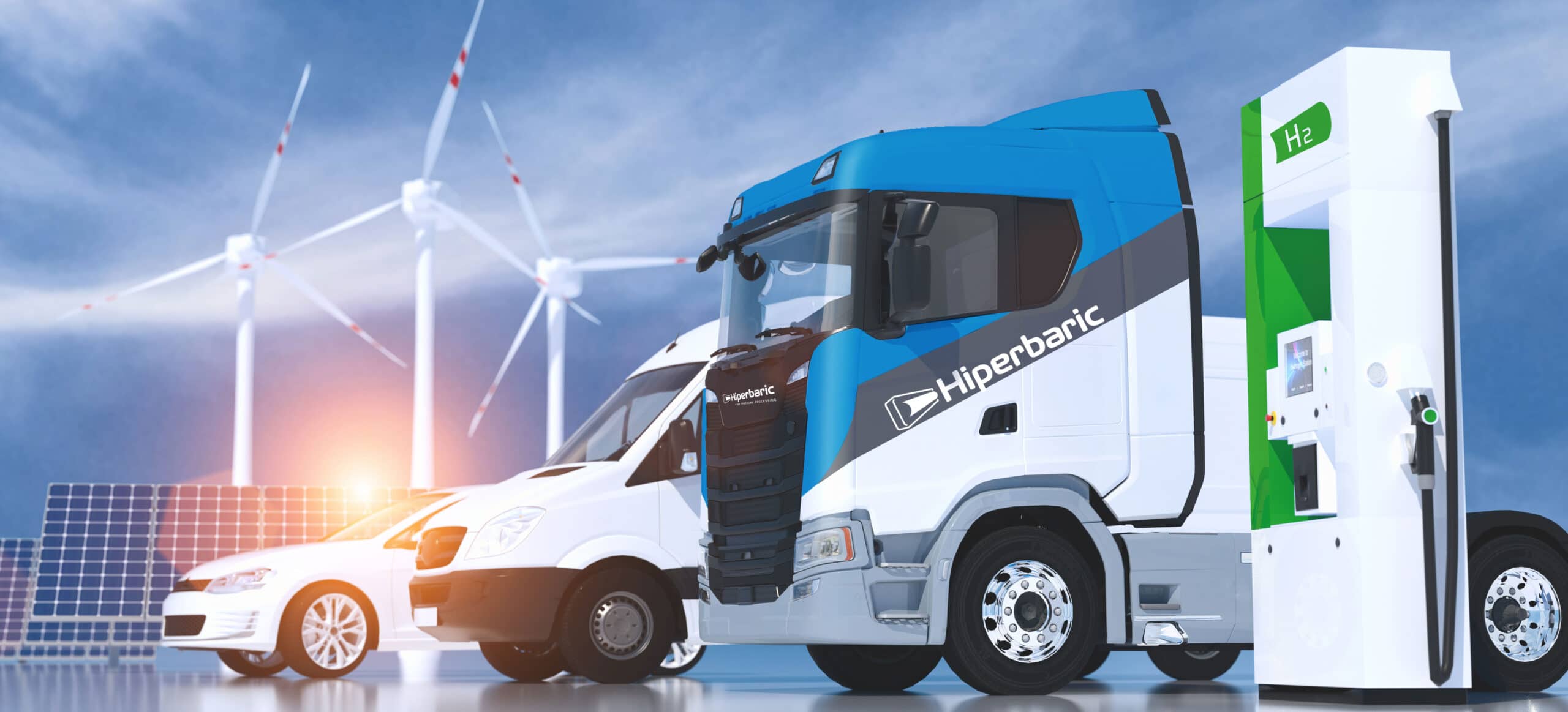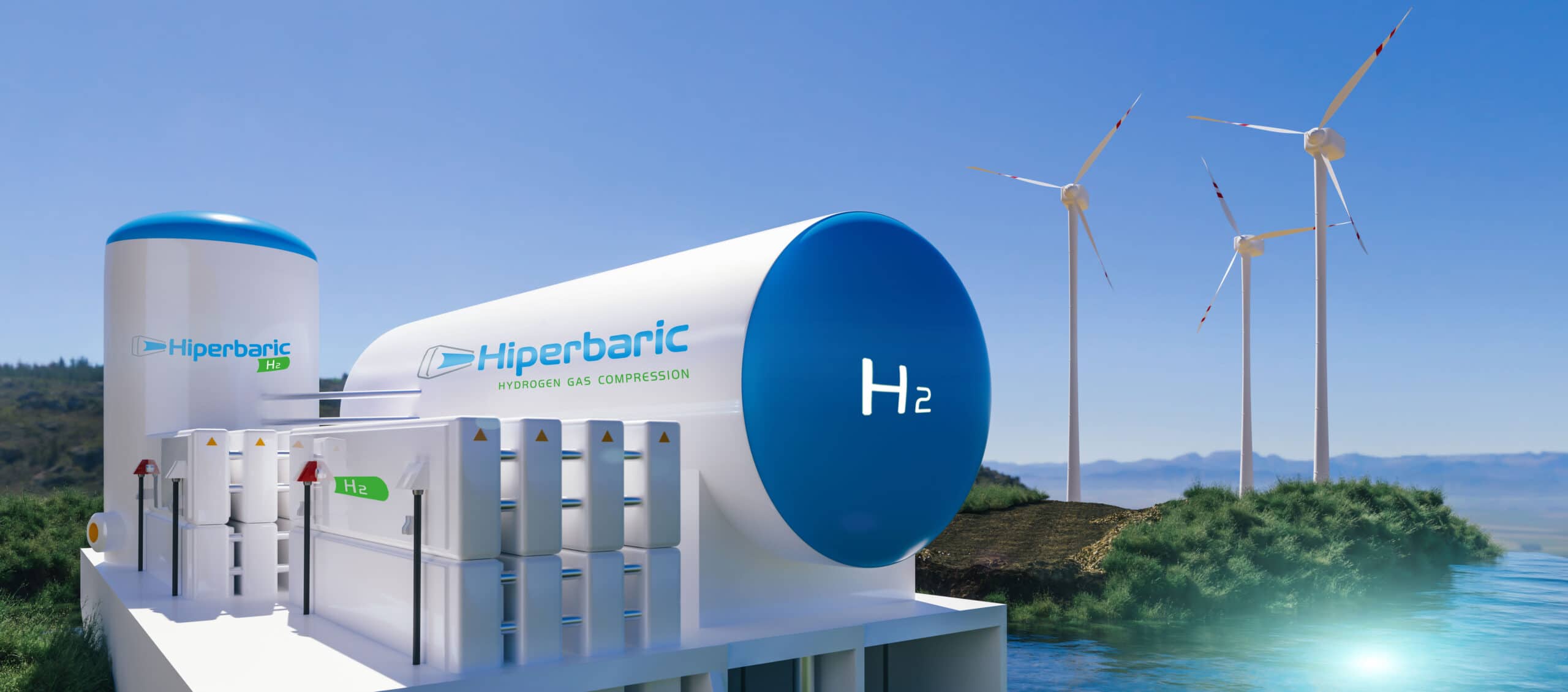The compression of hydrogen at high pression can be applied to various different sectors, particularly to new means of sustainable mobility. At Hiperbaric, we develop hydrogen compressors and offer our engineering and technical advice service to companies, research centers and any public or private entity that wishes to carry out a project related to H2 compression.
MOBILITY AND H2 FUELING STATIONS
HYDROGEN FOR THE MOBILITY OF THE FUTURE
Renewable or green hydrogen is one of the most viable and attractive solutions to replace the current transport and energy industry models. Thanks to this, sustainable mobility projects will be able to continue advancing in the future thanks to hydrogen. In addition to promoting the use of emission-free cars (only water and water vapor are released through the tail pipe), vehicles propelled by hydrogen already have the same range as many other saloons (up to 900 kilometers) and can be refilled completely in just 5 minutes.
The hydrogen storage and refilling infrastructure, or hydrogen stations, allow H2 mobility technology to be rolled out. These stations have the potential to process the hydrogen on-site or have it transported to the station ready-processed.
Before hydrogen can be used to fill a fuel cell vehicle, it first needs to be compressed using hydrogen compression equipment supplied by Hiperbaric. At the hydrogen stations, hydrogen gas that has been compressed at a high pressure is pumped into vehicles in a way that is quick, clean and safe.
Hydrogen stations are designed to provide services to cars using the road network. At these filling station, hydrogen is dispensed at a high pressure: 350 bar for use in buses and trucks, and 700 bar for use in saloons, offering the vehicle excellent range. Refilling is simple and agile, with complete safety guaranteed.
The time it takes to refill a hydrogen-powered vehicle is similar to the time it takes to fill a regular fossil fuel-powered car.

COMPACT AND EFFICIENT HYDROGEN
Storing H2 is one of the key factors to boosting the hydrogen economy. For decades, storing this gas has been a particular challenge, among other things due to its very low density, meaning that tanks with a huge volume were needed to store it, and also because it is a quite flammable gas.
Compressing hydrogen at high pressures is one of the most wide-spread, efficient, safe and sustainable methods of storing the gas. H2 is collected in high-pressure storage systems and containers, with typical pressure levels being between 200 and 900 bar, depending on the final use of the hydrogen. It can be stored as a gas in different types of containers, such as portable or stationary above-ground containers or underground caverns.
The main sector that benefits from storing hydrogen is sustainable mobility as a result of its use in hydrogen filling stations. Another one of the major uses of storing hydrogen is in solar and wind energy plants which accumulate surplus energy produced during the peak generation hours in the form of hydrogen so that it can later be stored and used during periods with greater energy demand, acting as an energy vector.
There are currently several different lines of investigation centered around storing hydrogen.

HYDROGEN STORAGE
HYDROGEN R&D
NEW LINES OF RESEARCH INTO H2
After several decades of researching production and usage techniques for renewable hydrogen, it has now realized its full potential as one of the fundamental elements to help us become carbon neutral by 2050, with many considering it to be a key factor in the decarbonization of the mobility sector.
In order for the hydrogen sector to become a reality, it is still necessary to continue along the path of researching and developing new technologies, processes and solutions for the entire value chain.
Some of the more high-profile research lines are those that are related to developing fuel cell vehicles with greater range and complete reliability. However, a key aspect to consider in sustainable mobility is the creation of an extensive hydrogen supply network for which it is essential for each country to develop their own technology for producing, compressing and storing the gas.
Hiperbaric is committed to developing reliable and versatile technology that helps create synergies with the rest of the steps along the chain. For example, it's worth highlighting that the wide range of input pressures that it functions with enables it to work both in the production phase, as it can be supplied directly with an electrolyzer, as well as in the storage and refilling stages, as it also boasts a wide range of output pressures.


